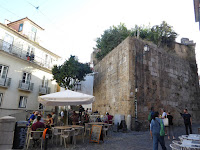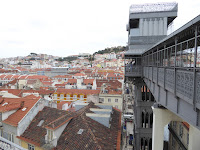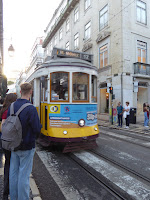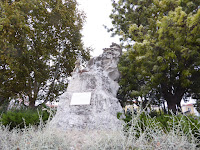 |
| Praca do Comercio |
Lisbon
We saved Lisbon for the end of our vacation (earlier blog posts highlight the other
destinations within Portugal). Although we loved everything we saw in Portugal,
Lisbon did not disappoint! It’s a sprawling city with many neighborhoods to explore,
along with some nearby destinations of immense historical importance (Belem and Sintra).
While Lisbon was settled in Roman times and the Moors in the 8th century,
the vast majority of sites date to the Age of Discovery (roughly 15th through 17th centuries).
King Manuel I reigned during the critical years of 1495-1521, and his “manueline
architecture” can be seen everywhere especially in Belem. During the 200 years
that Portugal dominated global exploration, it was the richest country in the west,
but declined because of the end of the royal bloodline and subsequent
War of Portuguese Succession, with Philip of Spain being crowned King of Portugal.
The great earthquake of 1755 destroyed much of Lisbon.
King Jose was so traumatized he left Lisbon and delegated reconstruction to
Marques de Pombal, whose designs are very reminiscent of Paris.
Lisbon is an interesting mix of Moorish, medieval, manualine and “Pombal” architecture!
Exploring Lisbon neighborhoods
The best part of visiting Lisbon is to explore the neighborhoods. We took a guided
food tour that gave us a nice introduction to the most historic neighborhoods,
as well as to Lisbon history, culture and food. Inside Lisbon was excellent,
our guide was enthusiastic and knowledgeable. Our tour included a water
taxi to Cacilhas for a seafood lunch and views of Lisbon across the Rio Tejo.
At the center of three of the oldest neighborhoods is Castelo de Sao Jorge.
Walk up to the Castelo de Sao Jorge, which is a strenuous climb up steep streets
in the Castle District.
Alfama district
Near Castelo de Sao Jorge is Miradouro de Sao Jorge, which is one of the best
views of Lisbon. From there you can descend through the old Alfama with winding
streets leading to small squares (Largo Partas do Sol, Largo Santa Luzia and
Largo Sao Miguel) where you get a real feel for life in Alfama.
There are lots of tiny restaurants, and you can hear traditional Fado music emanating
from many of the bars and restaurants. Most of Alfama survived the 1755 earthquake,
so it is still a medieval village. Weaving through the winding streets eventually
leads down to the river and Praca do Comercio (rebuilt by Pombal).
 |
| Alfarma Streets |
 |
| Alfama Square |
 |
| Our Lady of Conception |
Baixa (lower town) district
Stretching north from Praca do Comercio is the Baixa. This whole neighborhood
was devastated by a 20 foot wave that followed the 1755 earthquake.
When you get to Rossio square, the streets are tiled in the pattern of waves to reflect
the extent of the flooding (half mile from the Rio Teja!). The parallel streets of Baixa
reflect Pombal’s architecture and are full of (mostly tourist) restaurants and shops.
 |
| Rua da Alfandega |
 |
| Praca do Comercio |
 |
| Praca do Comercio |
 |
| Rio Tejo from Commerce Sq |
Praca do Comercio (Commerce Square), which was the site of the royal palace
before the 1755 earthquake. You can see the influence of Pombal’s architecture
most especially here. You can literally walk into the Rio Tejo at the bottom of the square.
The cafes and restaurants of Commerce Square are usually jammed (and overpriced);
there is a great selection of cafes along Rua da Alfandega and Rua dos Bacalhoeiros,
just east of the square (leading back to Alfama), which are a better option.
From Commerce Square, walk through the giant Arch of Triumph with Vasco da Gama
on the left and Pombal on the right (a bit of self-aggrandizement), emerging on Rua Augusta.
Explore the five parallel streets (remember, this whole area was completely rebuilt
after the earthquake and modeled after Paris streets). These streets lead to
Praca do Figueira (Fig Tree Square) or Rossio Square.
 |
| Baixa Tiled Street |
 |
| Praca do Figueira |
Just east of Praca do Figueira is Largo Sao Domingos with the Sao Domingos
churned that burned in 1959, and with no money for repairs merely constructed
a ceiling over the massive nave. It’s an incredible site to visit. Also on this square
is the tiny store at Largo Sao Domingos 8, which is the oldest ginjinha bar in Lisbon.
Ginjinha (sheen-SHEEN-yah) is a favorite sour cherry liqueur in Lisbon,
dating back to medieval monks.
 |
| Sao Domingos |
 |
| Sao Domingos |
when parishioners of this church slaughtered thousands of Jews in this square
(see the memorial near the church entrance).
 |
| Jewish Memorial |
Another block east is Rossio square. The National Theater is at the site of the
former headquarters of the Inquisition, which was destroyed by the 1755 earthquake
and replaced by the National Theater. With the theater to your back, look toward the
fountain and notice the “waves” in the tiles (explained earlier).
 |
| National Theater |
Looking toward the theater, on the left is the beautiful Rossio train station, you can’t miss the
faux manueline architecture.
%20Workers%20Memorial.JPG) |
| Tribute to Tile Workers |
 |
| Rossio Station |
This station has trains to Sintra, but you can also take the escalators for a free trip to the
upper Bairro Alto neighborhood - the other alternative is to take the Elevador Santa Justa
(1 block . To the right of Rossio station is the Hotel Avenida Palace, the oldest in Lisbon.
he hotel has a great bar off the lobby (try the lemon drop martini or mezcalita).
 |
| Elevador Santa Justa |
 |
| Elevador Santa Justa |
 |
| Hotel Avenida Palace |
 |
| Elevador Santa Justa from Bairro Alto |
Continue north from the Hotel Avenida Palace for one block to Praca dos Restauadores.
Look across the street and notice the quiosque (kiosk), you will see these all over the city
serving coffee and drinks.
 |
| Praca dos Restauadores |
 |
| Rossio fountain |
The Elevador da Gloria funicular to the Bairro Alto is just north
of the Obelisk, on the left.
 |
| Elevador da Gloria |
 |
| Lisbon Trolley |
From Praca dos Restauadores, Avenida Liberdade is a
tree-lined boulevard and the most elegant shopping street in Lisbon (out of my price range).
Hotel: we stayed in the Baixa neighborhood because it is central to all the other
neighborhoods we were exploring. The Hotel Santa Justa is located 1 block south of
Praca do Figueira on Rua dos Correeiros. The hotel is quite nice, clean and well priced
(a suite cost less than a standard room at “chain hotels” like Marriott).
There is a taxi stand, bus stop (15E to Belem), small grocery store and several restaurants
and pastry shops on Praca do Figueira. There is also a large grocery store across from
Praca Martim Moniz (near the Martim Moniz metro stop). We had a nice dinner at Sebastião,
a block from our hotel and less touristy than others in the area (the veal steak was delicious).
Mouraria (Moorish) district
From Praca do Figueira to the northeast, go to Praca Martim Moniz who used his body to
hold open the Moorish castle gate and allow the Christian Portuguese soldiers to capture Lisbon
from the Moors in 1147 (see this depicted in the tiles at Sao Bento train station in
Porto - see earlier post). Walk through the Centro Comercial da Mouraria market.
Follow Rua de Cavaleiros into the Mouraria, with tiny winding streets, ethnic restaurants
and pastry shops. At the top of the hill is Largo Rodrigues de Freitas with lots of restaurants,
and Portas do Sol for great views.
 |
| Mouraria Street |
 |
| View from Castle |
Bairro Alto (High Town) and Chiado districts
Ascend to Bairro Alto from Baixa either from the Elevador da Gloria funicular off Praca dos
Restauradores, or the escalators in Rossio Station, or the Elevador Santa Justa
(on Rua Santa Justa). Once on Bairro Alto, make your way to
Miradouro de Sao Pedro de Alcantara park (at the top of the Elevador da Gloria funicular)
for a great view of Lisbon.
 |
| Bairro Alto Rua Nova Trendade |
 |
| Bairro Alto Street |
A short walk to Sao Roque Church, the Chapel of John the Baptist
is the most expensive chapel in Portugal with precious metals from explorations.
 |
| Chapel of John the Baptist |
 |
| Sao Roque Church |
 |
| Sao Roque Chapels |
 |
| Sao Roque Church |
Farther down Rua Nova Trindade is Cervejaria Trindade, oldest beer hall in Lisbon,
and once a dining hall for Monks. During the Europe-wide social movement of the 1830’s
which secularized much of Europe (Socialism emerged from this), the Portuguese Republic
transferred much church-owned property to the public domain. Many public buildings in
Portugal were previously church properties, with the Cervejaria being an example.
Try their beers, including a really crisp IPA.
 |
| Cervejaria Trindade |
Antonio de Oliveira Salazar ruled Portugal from 1926 to 1968, longest running dictator in Europe.
His successor Marcelo Caetano took refuge in this building during an uprising, and was ousted
from power during the “Carnation Revolution” that took place in this square.
The Convento do Carmo which was badly damaged in the 1755 earthquake and never restored.
The Elevador de Santa Justa is behind the Convent, with stairs leading down to the Baixa.
Leave the square on Travessa do Carmo, left on Rua Serpa Pinto to reach Rua Garrett.
 |
| Bertrand Books |
 |
| Rua Garrett |
 |
| Rua Garrett |
 |
| Rua Garrett |
Both directions on the street are worth exploring (talking a left leads downhill to the Baixa).
Cafe A Brasileira is a beautiful 100-year-old Art Noveau cafe, Paris em Lisboa is an
historic fabric store, and Bertrand is reputedly the oldest bookstore in continuous operation
(since 1732) in Europe.
 |
| Cafe Brasileira |
 |
| Paris em Lisboa |
A few blocks south on Rua do Loreto is Miradouro de Santa Catarina with great views of Lisbon
and a monument to the “Tormentor” of the Cape of Good Hope (Vasco da Gama).
 |
| Miradouro de Santa Catarina |
 |
| Miradouro de Santa Catarina Tormentor |
 |
| View from Miradouro de Santa Catarina |
We had dinner at Pizzeria Mezzogiorno on a cute, quiet courtyard just off Rua Garrett, where there are two other restaurants as well.
Getting around Portugal:
Portugal was wonderful and exceeded our expectations. The highways are great, but driving
in large cities is not advised. The trains are easy to use, but connections to smaller cities are limited.
Within the cities, buses are relatively easy. Portugal is the most cash-centered economy I’ve
experienced in the EU, so make sure you have Euros (including coins and €5 currency).
While most people spoke English, I kept Google Translate open on my phone and it was indispensable.
For travel guidance, we have been using Rick Steves books since our first trip to Europe in 1989! They have great walking tours and incorporate details of history, culture and food that add context to everything you experience.

